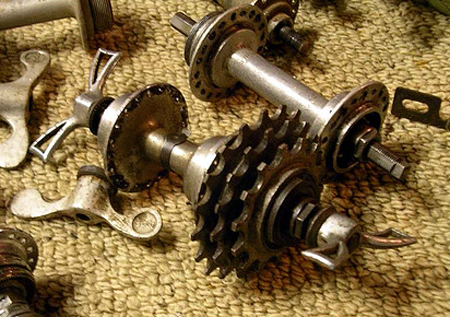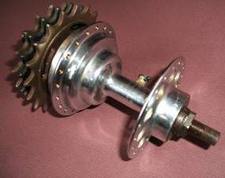Bayliss-Wiley Unit Hub: Ahead of its time
 Tue, April 5, 2011
Tue, April 5, 2011 
My first serious lightweight bike was a modest Dawes made of Reynolds 531 tubing. It had a cottered steel crank with a single chainring, and a Simplex derailleur with 3x1/8 inch sprockets.
The rear hub was a Bayliss-Wiley “Unit” hub as it was known. (Pictured above.) Freewheels had always been a separate item that screwed to the hub, this one had the freewheel built into the hub as a single unit, hence its name.
Today we call this a cassette hub and is the standard equipment on most high end and even moderate lightweight bikes.
The Bayliss-Wiley Unit hub was introduced in 1938, and was produced until 1957. Not particularly lightweight it was never considered to be racing equipment, but was used by club cyclists, tourists, and young kids like me who were just starting out.
Looking back it was really ahead of its time and it would be 30 years later that the Japanese company Suntour introduced another, and failed. It wasn’t until the top two manufacturers, Shimano and Campagnolo introduced their cassette hubs that people took them seriously.
The freewheel was always considered an item that would wear out long before the hub, therefore at one time it made sense to have it be a separate component that could be unscrewed from the hub and replaced.
 It wasn’t until freewheels went beyond six sprockets to 7, 8, 9, and 10, that an all in one unit or cassette hub was considered practical.
It wasn’t until freewheels went beyond six sprockets to 7, 8, 9, and 10, that an all in one unit or cassette hub was considered practical.
The Bayliss-Wiley Company was located in Tyseley, Birmingham, England and was founded by Cecil Bayliss and Arthur Wiley in 1919.
The company had what we would call today a niche marlet; they produced inexpensive but high quality bicycle components. Bayliss-Wiley kept the British working man on the road, back in the day when the bicycle was often the only form of transport for the working class.
They primarily made hubs, single speed freewheels, and bottom brackets; the parts that wore out and needed regular replacement. The company thrived through the 1920s, 30s and 40s, but not surprisingly declined in the late 1950s, when the British working man abandoned the bicycle and started buying cars for the first time.
Taken over by Reynold Chains Ltd., the Bayliss-Wiley name finally disappeared in 1969. One of the most recognizable brand names when I started cycling in the 1950s, but not too many of today's generation will have heard of Bayliss-Wiley even in the UK.
You can read more on Ebykr.com

























Replacing McQuaid: Mission Impossible
It appears you may as well try to oust the Pope as try to get the UCI’s president Pat McQuaid removed from office.
This doesn’t surprise me, I have seen the workings of Cycling’s national governing bodies both in the UK and the United States, and they are structured pretty much the same as the UCI is described.
Clubs affiliated to their national governing body send delegates to an annual congress where officials are elected. These officials in turn become national delegates and get to elect a President and other officials at the world level at the UCI Congress held every four years.
At the club level and even at a national level, work is often on a volunteer unpaid basis; however, if you get elected to a national level there are certain perks. Travel is one of them; an all expenses paid trip to Switzerland every four years to the UCI congress for a start.
Then there is the Olympic Games every four years; who wouldn’t like to go to the Olympics for free? The top officials that represent each individual sport for each country get to go. There is an awful lot of working hard for little or no reward to get to these top positions, but when you get there it is like being the member of an exclusive club.
So having worked so hard to reach the top, even at a lower national level, are you going to make waves at a world level and vote the head guy out of office? Unlikely, unless you have aspirations to be President yourself, in which case you had better have a lot of buddies who you can count on to vote for you.
I’m sure many of the people who voted McQuaid into office ended up with nice paying jobs with the UCI. Others no doubt get to go to big races all over the world. The Tour de France, The Giro d’Italia, etc, etc.
If you are one of McQuaid’s cronies why would you vote him out? You would have to start all over again to ensure having an “In” with the new guy. If you back the wrong guy and he doesn’t get voted in, you lose; you are out of the exclusive club for ever.
McQuaid was first voted into office in 2005, and re-elected in 2009. The next vote is not for another two years in 2013, and there is no guarantee he will step down then.
In the mean time the Professional Riders might break from the UCI and form their own league, rather like the NFL and the NBA.
This looks like a distinct possibility, because McQuaid will stay where he is at least until 2013, and the UCI is not going to change. For that to happen the whole system would have to change, right down to the national and even the club level.